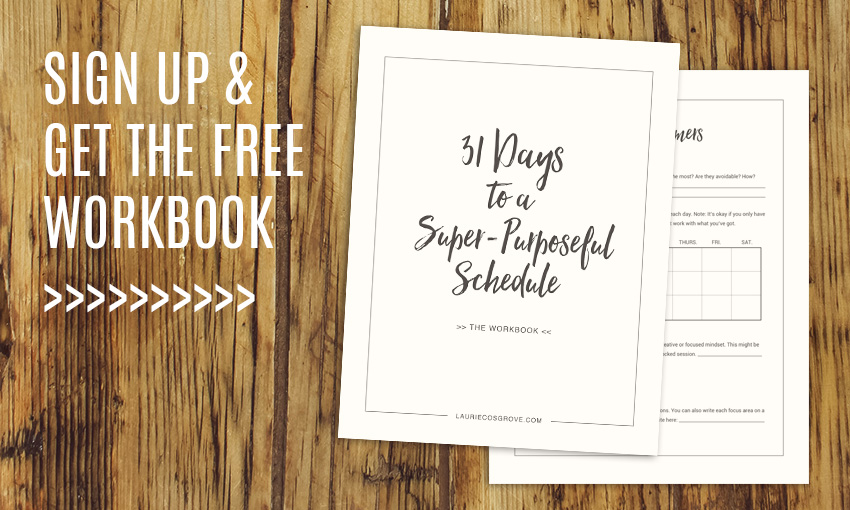Purposeful meal-planning
(Photo by Rachel Wakefield)
This post is Day 12 in the 31 Days to a Super-Purposeful Schedule series.
Before we get started today, I have to warn you I'm sick with a cold so my thoughts are a little bit fuzzy. Hopefully I can make enough sense to share some tips and goals with you anyway!
What's for dinner tonight?
Oh man, did I just stress you out and remind you of all the things you still need to decide? This is one of those questions that used to make me cringe if I didn't have a plan. Before my son went on a modified version of the GAPS diet (for autism and tummy issues) I never had a plan. I was not the best cook, bought convenience food regularly, and probably wasted a lot of money eating out.
(To sum up the main points of the diet, basically I had to eliminate all processed food, grains, most dairy and all sweeteners besides honey. This meant for those 12 weeks, I NEEDED to have a plan and make a lot of meals quickly. I'm still working on my cooking skills, but the planning ahead skills have gotten much better. And his tummy issues? GONE. Thank you, GAPS diet.)
I could share with you a lot of different ways to batch process your meal planning like doing freezer meals or buying in bulk, etc. But let's keep it simple and focus on one thing that you and I can do now to be more purposeful with our time.
The number one thing I learned during those 12 weeks was this...
It Pays To Plan For Extras.
When you make a meal, make a few extra servings so there's always leftovers.
Don't just plan one meal at a time but do a week at a time so you can create spin-off meals for things with similar ingredients.
Plan for all of your dinners to become the next day's lunch.
In this way, you'll save yourself a lot of cooking and stressing.
Tips For Making It Work
1 | Buy REAL food
In order for this to work, we have to be smart shoppers. Be choosy with what you buy.
Foods like Vegetables, Fruit, Meat, Beans, Nuts, Almond Flour, etc. are all ingredients that can be used in a LOT of different meals. Not only are they better for you, but you can stretch them and improvise with them to create extra meal ideas.
Convenience foods like frozen pizza, tv dinners, and meals in a box? These can make one thing and one thing only. There is no adding extra servings or double batches. There's not as much freedom to create a second meal from them.
2 | Create a menu guide
I've shared in a previous post how I created a menu guide to plan 9-weeks of meals at a time. (Note: These are pre-GAPS meal plan ideas so you're better off starting here if you want to try the diet.) So much of our time can be spent browsing Pinterest, food blogs or cookbooks for what to make on the fly. If you're doing this every night and going to the store before every dinner, your time is just slipping away. A menu guide can help you put all of your favorites on rotation so you don't have to think about it too much.
3 | Go to the store ONCE a week
Or twice if you really need to. But staying out of the store protects your schedule and your wallet. Plan your meals for the week and then stick to them. If you forget an ingredient, you can run back or just improvise with the real food I mentioned above.
Too Busy To Cook At Home?
The number one fear I had when I started the GAPS diet was that I was far too busy for all of this home-made cooking. I was pregnant at the time, had two toddlers running around - obviously one with special needs, and a business to maintain.
I was shocked that it really didn't take more time. Especially with that secret weapon of planning for extras. I DID have more dishes, but I also had more peace. I've gotten into some bad habits over the summer and I realized that rushing around to the store, fast-food restaurants, and planning meals the day I eat them is REALLY stressful.
How much better would it be to put some music on, stay home in your peaceful kitchen, let the kids help with adding ingredients and have a fridge full of leftovers for the next day's lunch? Plus you get the added bonus of knowing you're feeding your family good food and not junk.
Win-win:)
TODAY'S ACTION STEP:
Create your meals in advance this week and plan for extras. Schedule a time for you to decide what you're making this week and when you'll be shopping. You can use the space in your workbook to write down your favorite go-to meals. (*Note: if you're already subscribed and are having trouble accessing this page, email me for a refresher on the password. xo)













